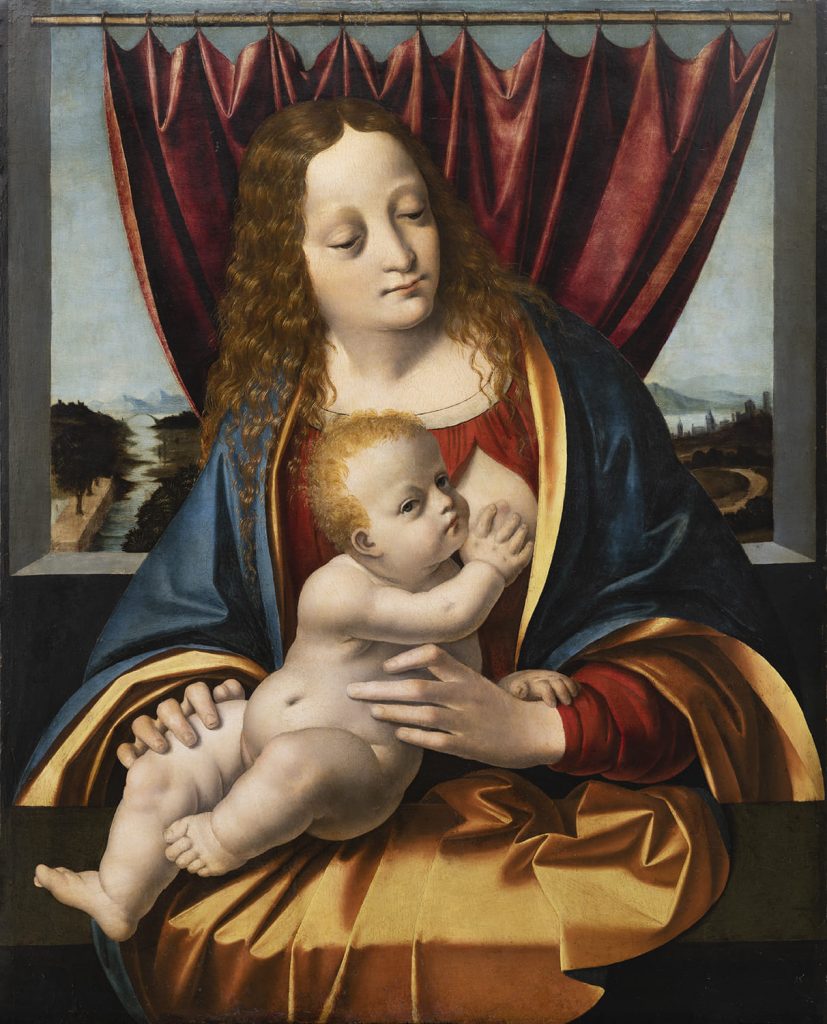OGGIONO
CITY OF MARCO
INTRODUCTION TO the artist
Tradition says that Marco d’Oggiono was born in Oggiono in the locality of ad Calcheram (present-day Piazza Sironi), in a house owned by his parents Cristoforo d’Oggiono, a successful goldsmith, and Elisabetta da Clivate (Civate).
The date of his birth is uncertain, presumed to be between 1465 and 1470. This time frame can be deduced from the fact that Marco, was already a recognized master and thus at least 15 or more likely 20 years old, in 1487 when he hired as an apprentice Protasio Crivelli to teach him the art of miniature painting, a specialty in which Marco had apparently established himself early on.
According to chronicles, Cristoforo d’Oggiono had moved the family residence to Milan at least since 1477. Marco lived in the district of San Galdino, where his father owned a workshop in the contrada dei fabbri.
Marco was a goldsmith, miniaturist, designed tapestries, and above all was a well-respected painter in his time. Due to a lack of explicit documents it is complicated to shed light on the artist’s beginnings; however, there is evidence of his frequentation of Leonardo’s studio, noted on September 7, 1490, and of his co-production, together with Giovanni Antonio Boltraffio, of the altarpiece for the chapel of San Leonardo in San Giovanni sul Muro in Milan, the negotiations for which date from 1491. To receive such an important commission having as a partner a distinguished colleague, Marco must have already been an established painter, and thus even Leonardo’s magisterium cannot be understood as an apprenticeship phase, but rather one of refinement.
Certainly Leonardo’s influence was for Marco, as for many of his contemporaries, decisive, to the point of originating a whole production in imitation of the master’s manner.
Marco d’Oggiono has all the characteristics of the professional painter, in demand by public and private patrons, engaged with continuity in the creation of cycles of frescoes and altarpieces, preferably related to the traditional scheme of the polyptych.
His works are housed in important museums around the world and in some churches in Lombardy and Liguria.
Polyptych of the Assumption and eight saints
MADONNA BETWEEN SAINT EUPHEMIA AND SAINT CATHERINE OF ALEXANDRIA
MADONNA AND CHILD, SAINT JOHN AND AN ANGEL
GROTESQUE
THE ELEVATION OF SAINT MARY MAGDALENE
GIRL WITH CHERRIES
Salvator Mundi
LAKE LANDSCAPE
MADONNA LITTA
ALTARPIECE OF THE THREE ARCHANGELS
‘THE ARCHINTO PORTRAIT’ OF FRANCESCO DI BARTOLOMEO ARCHINTO
SAINT SEBASTIAN
Polyptych of the Assumption and eight saints
Marco d’Oggiono,
1521 approx Oil on panel,
Oggiono, Chiesa Prepositurale di Sant’Eufemia.
Ten panels depicting:
In the upper part, the cymatium, with God Almighty carrying in his hand the crown destined for the Virgin Mary; in the middle, the most important panel, the Assumption, analogous to the version stored at the Pinacoteca di Brera in Milan; top left , St. Ambrose, Patron Saint of Milan, with episcopal clothing and armed with a stirrup leather to fight the Arian heresy and then St. Euphemia, Patron Saint of Oggiono, with a palm leaf symbol of martyrdom, and a saw, tool used to torture the woman.
Bottom left, St. Bernardine of Siena, portrayed as a thin, toothless and old man according to tradition, and St. Francis d’Assisi, with stigmas; top right, St. Apollonia, with the pincers used to cruelly pull out her teeth, and St.Stephen, the first of the Christian martyrs, with the rocks alluding to his stoning; bottom right, St. Sebastian, tied to a tree trunk, and St. Rocco pointing at the plague lesion on his thigh, with a pilgrim’s staff.
According to Malvezzi (1822) this panel is Marco’s last work, since “the apostles are not concluded, in consequence there is reason to believe that Marco was dead, therefore it was his last piece”.
At the time of the pastoral gathering held in 1608 by Cardinal Federico Borromeo this altarpiece was supposed to be arranged just like we see it nowadays.
Later on, different panels were dismembered and scattered around the church.
They were again reassembled in 1873 as is shown by an inscription located on the base of the polyptych.
The work is located in Piazza della Chiesa, 1, Oggiono LC.
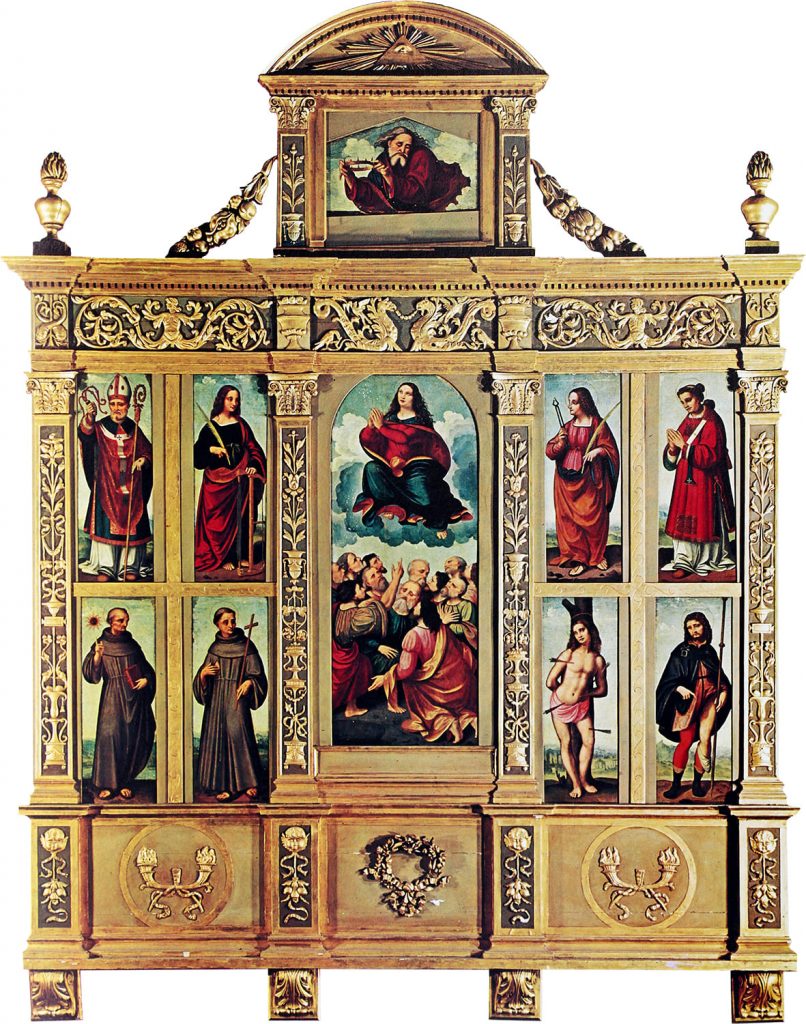
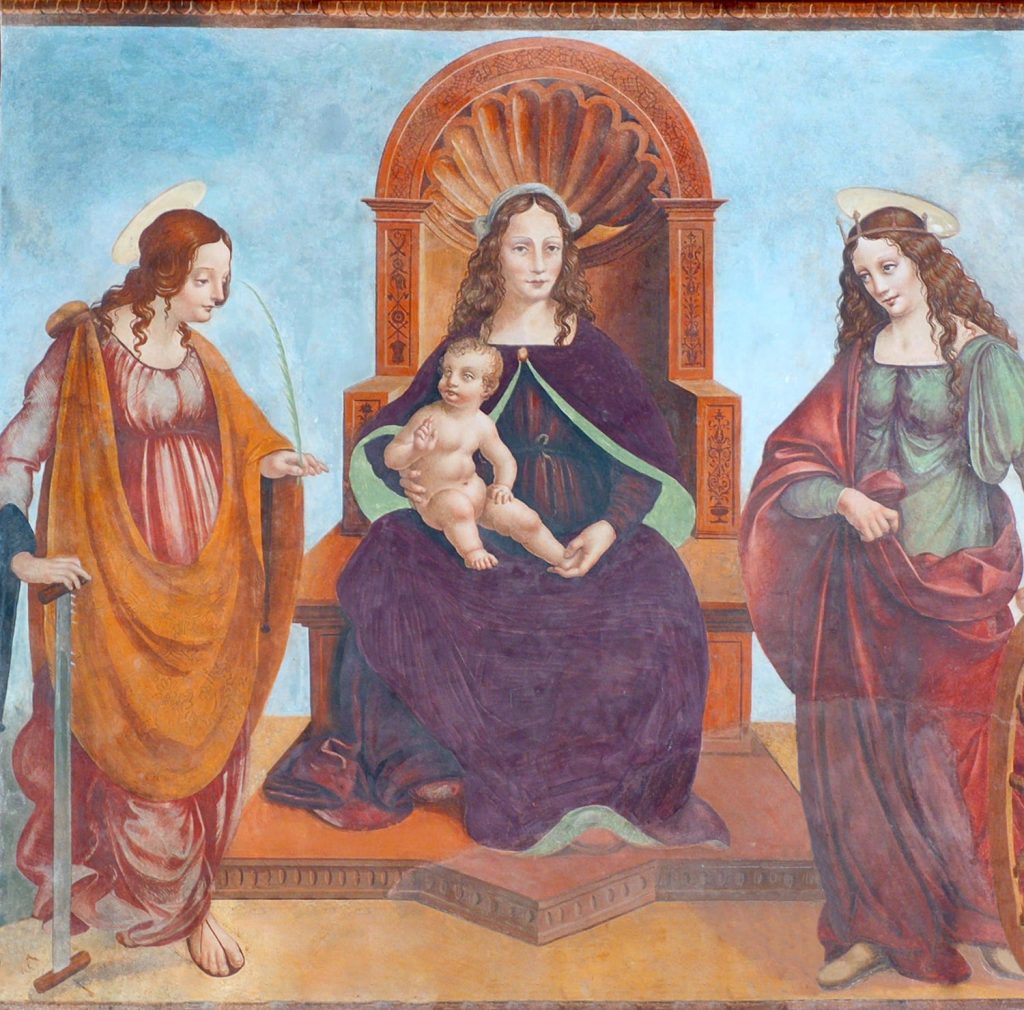
MADONNA BETWEEN SAINT EUPHEMIA AND SAINT CATHERINE OF ALEXANDRIA
Marco d’Oggiono,
16th century. Detached fresco
Oggiono, Prepositurale di Sant’Eufemia Church
Considered by Domenico Sedini as a “dignified work” from Marco’s studio in his monograph about the painter published in 1989, the fresco was later traced back to the hand of the Oggionese master by the art critic Franco Moro after its restoration in 1994.
The fresco, formerly transferred in block from the altar of St. Bernardine above a new altar dedicated to St. Magdalene, shows the enthroned Virgin flanked by St. Euphemia and St. Catherine of Alexandria. In a composition completely devoid of a background and therefore extraneous to the habits of the Master Leonardo. It is likely that the work was begun by Marco and completed by one of his students following his premature death during the plague of 1524.
The two martyr saints have in common that they underwent various atrocious tortures before being killed by sword, stabbed or decapitated, as narrated in the Leggenda Aurea by Jacopo da Varagine. They are depicted with one of the instruments of torture that appears in their respective hagiographies: Saint Euphemia with the saw and Saint Catherine of Alexandria with the cogwheel.
It is interesting in this context to remember the legendary anecdote according to which Euphemia, the patron saint of Oggiono, one day crossed Lake Como with a saw and a bell in her hand, to divide the waters.
When she almost reached the end of her journey, the bell slipped out of her hand, falling into the lake and rang. The sorrowful saint said: “Go down, go down, you will never touch the bottom”.
Legend claims that the tolling of the bell can still be heard as it continues to fall into the water during storms, when the waves whiten with foam and the lake becomes dark and violent.
MADONNA AND CHILD, SAINT JOHN AND AN ANGEL
Marco d’Oggiono,
1509 approx Oil on panel - front, 54 x 48 cm
Milano, Pinacoteca del Castello Sforzesco
© Milano / Beccaria Municipality
The painting accurately reproduces the pyramidal compositional scheme of the first Virgin of the Rocks of Leonardo da Vinci (1486 approx, Paris, Louvre Museum) which has as its theme the Immaculate Conception.
The painting depicts the Madonna sitting on the ground resting her right hand on Saint John’s shoulders, who is naked, kneeling and with his hands clasped together, receiving a blessing from the Christ Child, seated on the ground on the opposite side and protected by his mother’s hand above his head.
Behind him a kneeling angel supports his bust, while his face is turned towards the observer, he points to the Saint. The biggest difference to Leonardo’s original is revealed in the landscape, with more domestic tones: the vast lagoon view with mountains and villages seems to portray the landscape of Lecco.
Following a consolidated Humanistic tradition linked to the idea of rebuses and word games, Marco inserts in his version of the Virgin of the Rocks a functional element to celebrate the commissioner of the small panel, made for devotional reasons.
The burning bush behind Madonna, identified for the first time by the art
historian Alessandro Rossi in 2020, as well as symbolizing the Virginity and the Immaculate conception of Mary, would in fact allude, according to the scholar, to the surname of the possible commissioner of the work, Cardinal Giuliano Della Rovere, ascended to the papal throne with the name of Pope Julius II in 1503.
On the other side of the panel there is also, framed by refined grotesques, an inscription in Greek in which reads translated: “Marco painted for Julius’’.
‘’Julius’’ that could be identified as Pope Julius II, documented commissioner, not only, as it is known, of great artists such as Michelangelo and Raffaello, but also of Marco of Oggiono himself, who created a series of work for the cardinal, partly lost, intended for the cathedral of Savona, Della Rovere’s hometown.
The family being closely linked to the Duchy of Urbino and the Papal States.
The work is located in Via Camillo Benso Conte di Cavour, Oggiono LC.
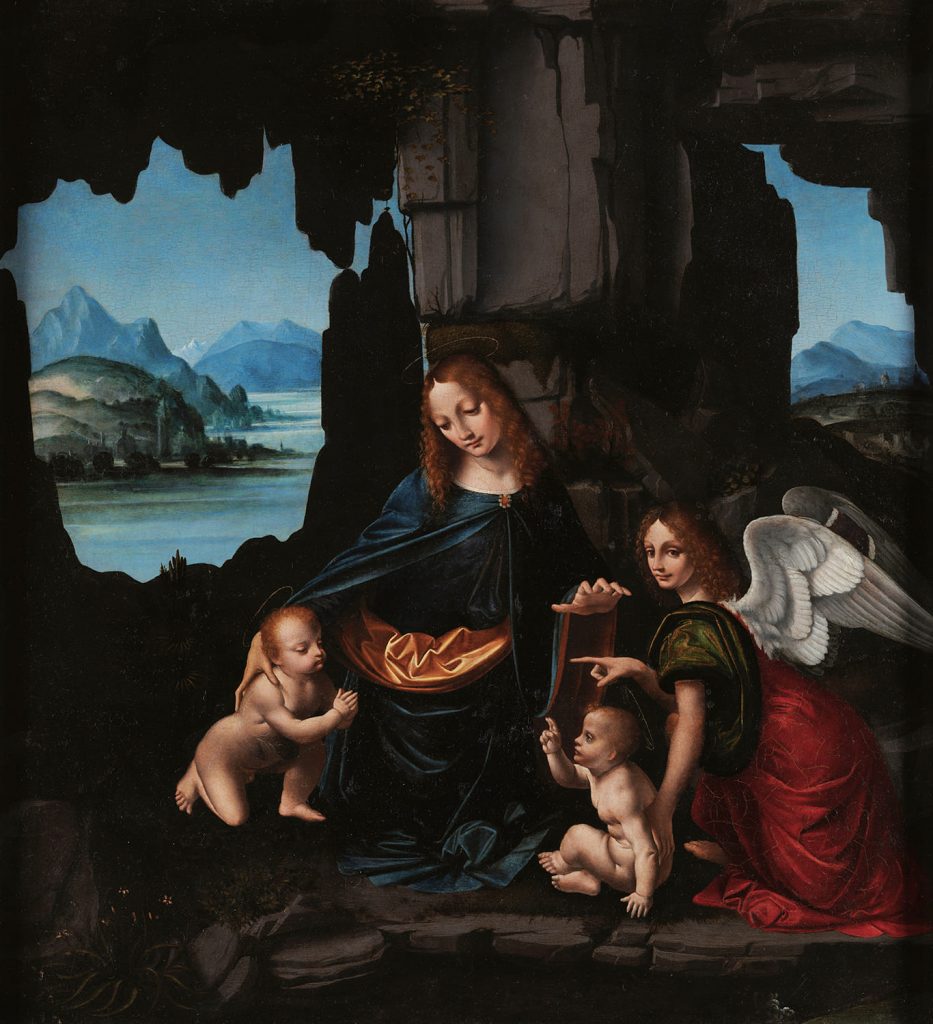
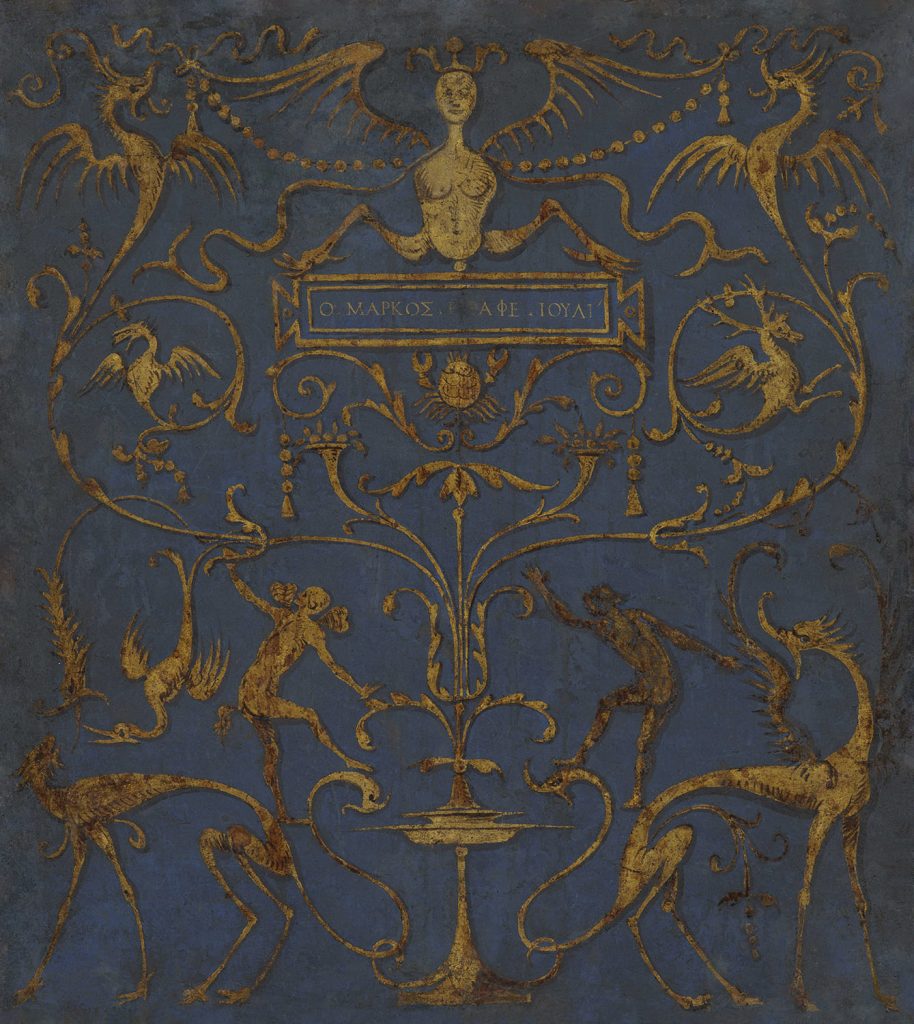
GROTESQUE
signed by Marco d'Oggiono and with an inscription in Greek on the back (side) of the Madonna and Child, Saint John the Baptist and angel
Marco d'oggiono,
approx 1509. Oil on panel - 54 x 48 cm
Milan, Pinacoteca del Castello Sforzesco
© Milan / Beccaria Municipality
The painting occupies the back of the artwork Madonna and the Child, Saint John and angel described in the previous panel. Grotesques are a particular type of pictorial decoration, generally parietal, which finds its roots in Roman painting of the Augustan era (44 B.C. – 14 A.D.) that was rediscovered and made popular from the end of the fifteenth century.
The grotesque decoration is characterized, as in this case, from the representation of hybrid and monstrous creatures, chimeras, harpies, satyrs, often portrayed as slender figures, deformed and capricious, that merge into complex compositions, symmetrically structured, on a generally monochrome background.
At the centre of the decoration, inside an Ansata classicist plaque, the inscription in Greek characters indicates the name of the author, of the painting and that of the commissioner or of the recipient of the artwork: “Marco painted for Julius”.
The work is located in Via Camillo Benso Conte di Cavour, Oggiono LC.
THE ELEVATION OF SAINT MARY MAGDALENE
Marco d’Oggiono (and assistants),
about 1522-1524. Oil and tempera transferred from panel to canvas - 146 x 103 cm
Milan, Pinacoteca di Brera
© Pinacoteca di Brera, Milan
The artwork, on a stylistic level is noted for, other than Leonardo’s influences, also the peaceful sweetness of Raphael and the sensuality of Correggio, represents Saint Mary Magdalene elevated to heaven by a multitude of angels.
The painting is presented in two different ways: that of the upper part with Mary Magdalene, the angels, the fluffy grey-blue clouds and God Almighty, in which the colour is given with flat backgrounds with little material, and that of the lower part, with the Ligurian seascape or Lecco-lake likeness, which is instead characterized by more mushy brushstrokes and with effects of a meticulous and accurate rendering of the natural elements, characteristic of the Flemish painting.
The discrepancy in brushwork is such that it is necessary to assume two different artists: it is thought, indeed, that Marco d’Oggiono executed the upper part of the board leaving to one of his students the task of doing the lower one, once sick with plague.
The painting was the protagonist of adventurous events during the twentieth century: it was purchased by Hermann Göring, for the Hitler Museum and recovered in 1954 by Rodolfo Siviero, a secret agent and art historian, and remained a few decades in Palazzo Vecchio in Florence.
The work is located in Piazza Sironi, Oggiono LC.
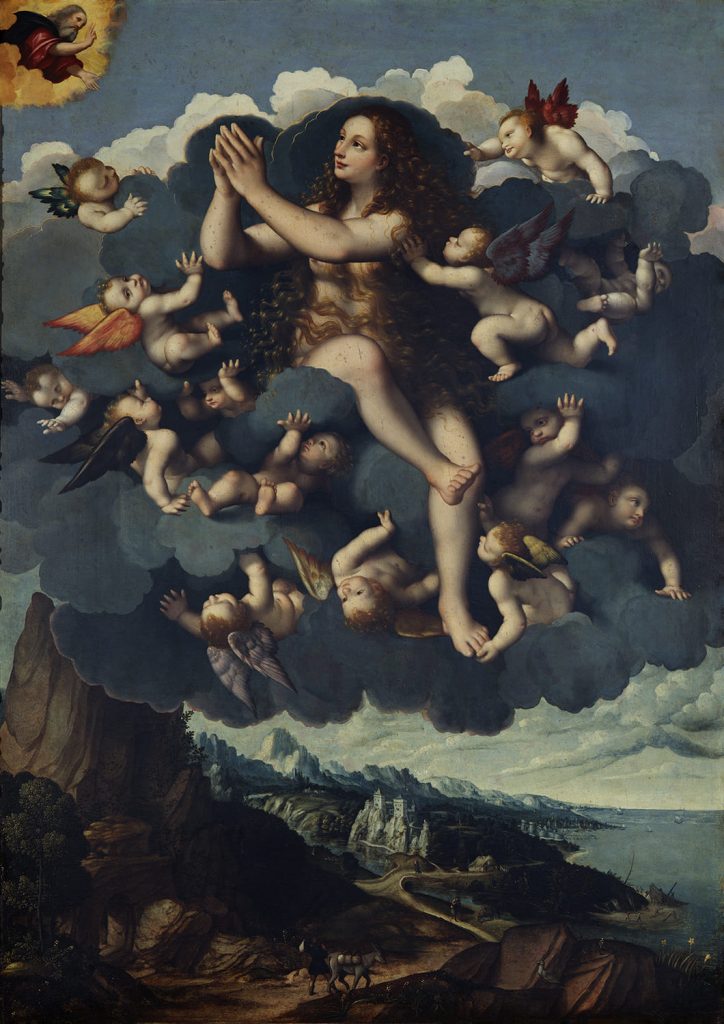
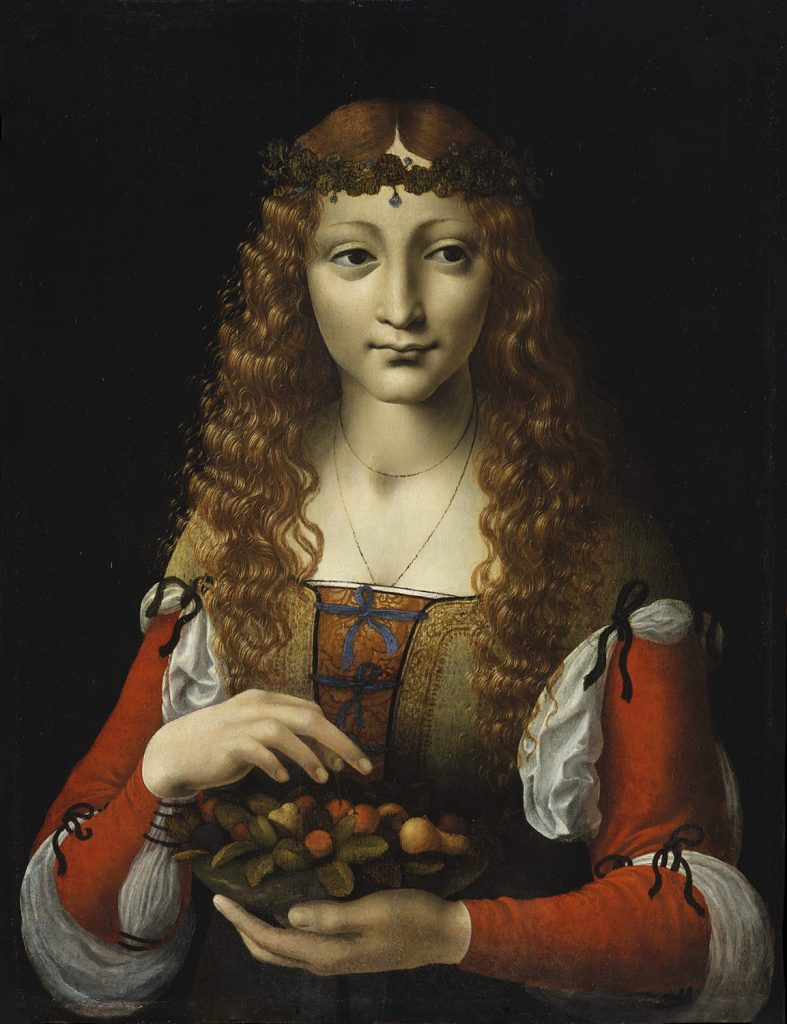
GIRL WITH CHERRIES
Marco d’Oggiono (attributed),
Approx 1491-1495. Oil on panel - 48,9 x 37,5 cm
New York, Metropolitan Museum of Art
© Scala
The work is located in Via Marco D’Oggiono, 14, Oggiono LC.
Salvator Mundi
Marco d’Oggiono,
Approx 1505-1510. Oil on panel - 33 x 26 cm
Rom, Galleria Borghese
© Galleria Borghese / foto Mauro Coen
The painting represents a blessing Christ, still without a beard (“de anni duodieci”) and dressed in a bright red robe and a blue mantle.
Jesus’ clothing colours are not accidental. Like the ones of the Virgin Mary, they are a reminder of how the sacred figure’s nature is human and divine at the same time: blue symbolizes the colour of the spirit and the sky, while red represents human emotions and the principle of life.
Christ holds a terrestrial globe, which accurately describes the geographical knowledge of the time, in his left hand. In fact, it seems Marco d’Oggiono owned some updated geographical maps.
The work is located in Via Giacinto Longoni, 20, Oggiono LC.

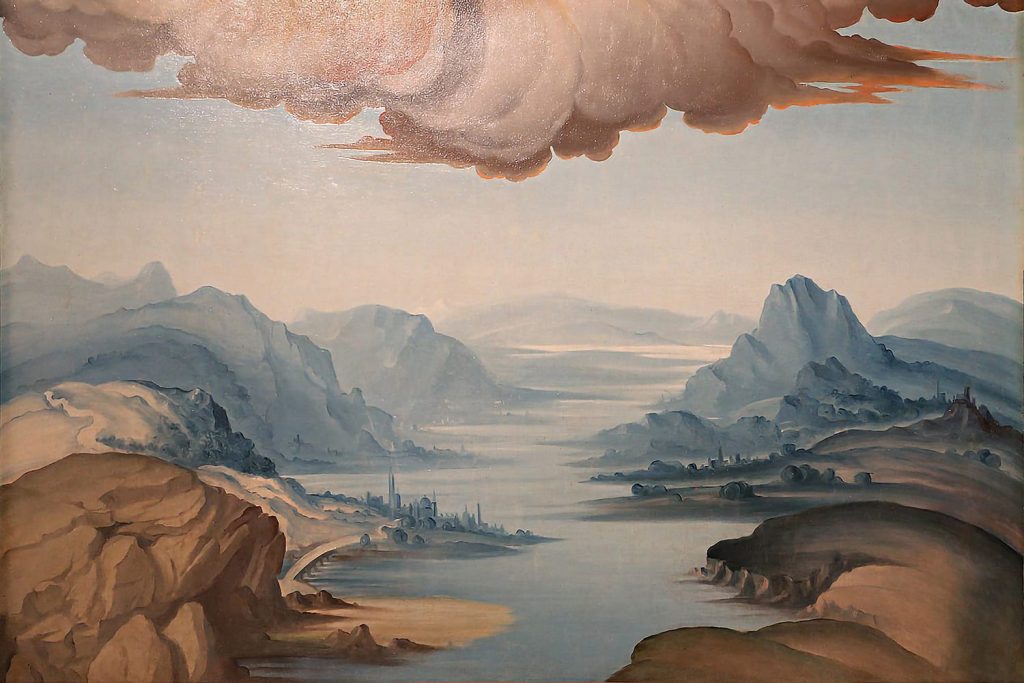
LAKE LANDSCAPE
Detail from the Polyptych Assumption of the Virgin Mary between the Saint John the Baptist and Saint Stephen
Marco d’Oggiono,
Approx 1510. Oil and paint on panel - 350 x 420 cm
Milan, Museo Diocesano, from Saint Stephen’s Church in Mezzana di Somma Lombardo (VA)
© Museo Diocesano, Milan
The lake landscape, depicted by using aerial perspective, clearly deriving from Leonardo’s painting style, is a clear reference to Lake Como, perhaps a view of Lecco seen from the south, spectacularly inverted, from the highlands of Brianza.
The detail is in the lower part of central panel near the Virgin’s feet. The Polyptych of Mezzana is the only structure with multiple fully preserved panels attributed to Marco d’Oggiono and still installed in the original wooden golden carpentry.
The frames of the altarpiece, which depict The Beheading of the Baptist, the Visitation, the Nativity and the Martyrdom of Saint Stephen, are separated from each other by images with figures of Saints on them. The scenes show a strong narrative focus and an almost miniaturist taste that frequently appears in the artist’s production.
The work is located in Via Giacinto Longoni, 24, Oggiono LC.
MADONNA LITTA
Marco d’Oggiono,
1490 circa. Tempera on panel - 42 x 33 cm
Saint Petersberg, State Hermitage Museum
© The State Hermitage Museum
The scene represented is of a poetic serenity sweetness: Our Lady, who is breastfeeding Infant Jesus (Madonna Lactans), shows him to the observer so as to participate in that moment of deep intimacy.
The Infant, who with childike curiosity realises, reciprocates the gaze of the viewer while that of the Mother, very sweet, lowers devoutly.
The face of the Virgin, of a lunar splendor, stands out on a dark background while on the sides two arched windows open that leave a glimpse onto some hilltops attributable to the Brianzolo landscape, characteristic of the paintings of Marco d’Oggiono.
The work is still at the center of a debate between specialists about its actual authorship. If the ideation, confirmed by some drawings, can be traced back to Leonardo, it is likely that its execution, which took place during the first stay of the Tuscan master at the court of the Sforza, is by Marco d’Oggiono with the collaboration of Giovanni Antonio Boltraffio.
The work is located in Piazza Giuseppe Garibaldi, Oggiono (LC) .
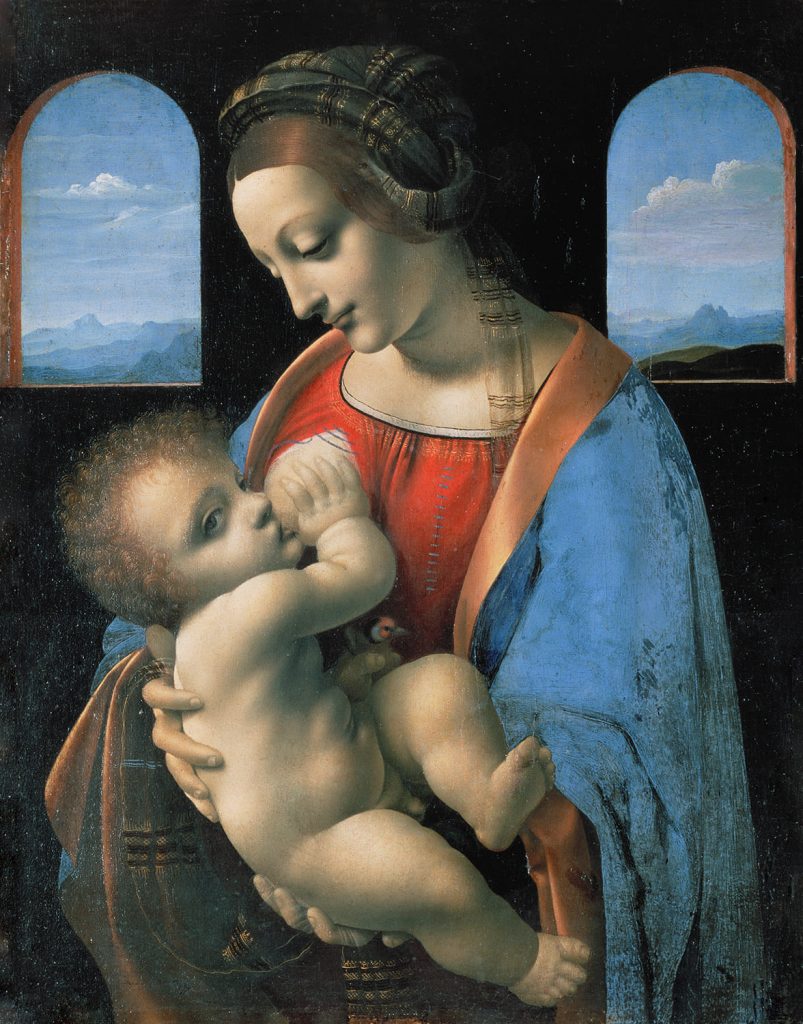
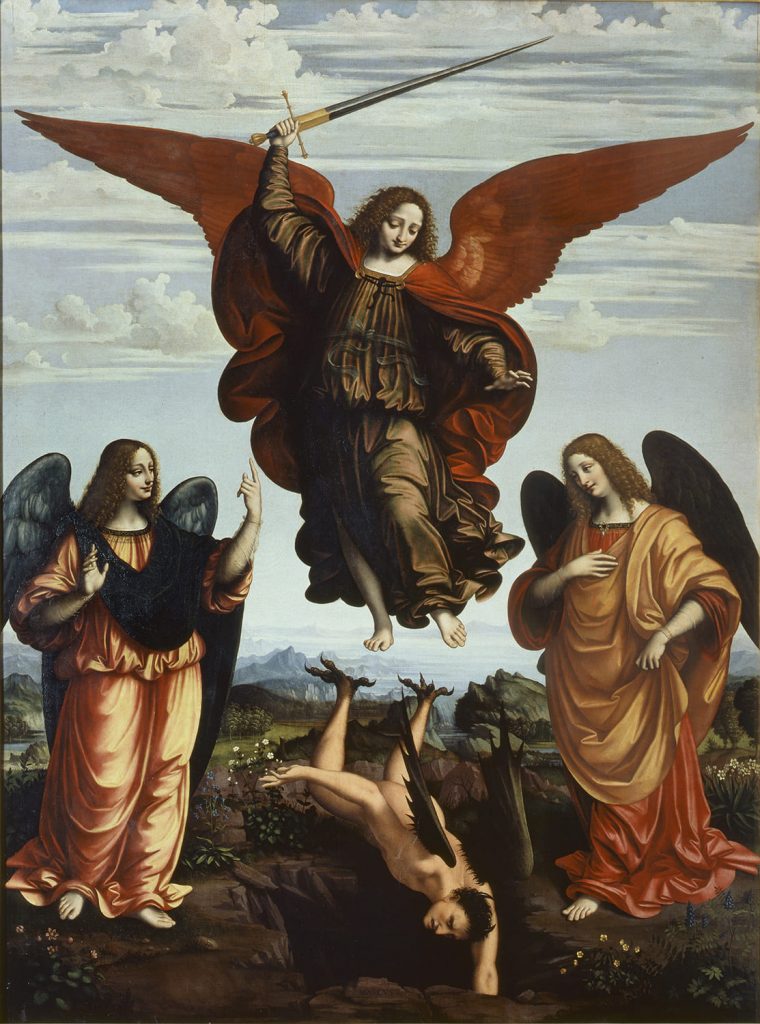
ALTARPIECE OF THE THREE ARCHANGELS
Marco d’Oggiono,
1516 approx. Oil on panel - 255 x 190 cm
Milano, Pinacoteca di Brera, from the Santa Marta alle Monache Church
© Pinacoteca di Brera, Milano
Masterpiece of the Brianzolo painter, it is a majestic painting created for the Augustinian convent of Santa Marta in Milan, commissioned as an altarpiece for the chapel of St. Michael.
The iconography is rather rare and seems to have been inspired by the Augustinian nuns who inhabited the convent, followers of the religious Amedeo Menesde Silva. The altarpiece arrived in Brera in 1806 as a result of the Napoleonic suppressions.
The painting, which depicts the episode of the Lucifer hunt by Archangel St. Michael, head of the multitude of angels, should be read as a metaphor for the spiritual renewal of the Church in place during those years.
The scene follows a very precise structure: in the center Archangel Michael, with a sword and whose wings touch both sides of the painting, is driving away the devil who is crashing to hell, while to his side Archangels Gabriel and Raphael observe the scene performing eloquent gestures.
The work is signed “MARCVS” in the foreground on the stone in front of the infernal chasm.
The work is located in Piazza Giuseppe Garibaldi, Oggiono (LC) .
‘THE ARCHINTO PORTRAIT’ OF FRANCESCO DI BARTOLOMEO ARCHINTO
Marco d’Oggiono,
1494 approx. Oil on panel - 54 x 38 cm
London, National Gallery
© The National Gallery, London
Milanese of Brianzola origin, in 1511 Archinto became governor of Chiavenna. He died in 1551 at the age of seventy-four.
As you can read on the scroll he has in his hand, Marco d’Oggiono portrays Archinto at the age of twenty while wearing an extremely refined outfit: a shirt, a blue doublet (jacket) knotted with a trimming (a strip of fabric or tape that was fastened in various ways) with a pellanda on top (a coat lined with fur, in this case characterised by a large collar hemmed with leopard fur) and his long, wavy reddish blonde hair, is topped with a black, felt hat.
The dark background, of Flemish origin, which the master Leonardo da Vinci uses in the renowned Lady with an Ermine, datable a few years earlier, represents a visual technique able to highlight the figure making it even brighter.
Particularly interesting is also the parapet in the foreground on which the protagonist of the painting rests her right hand, which, simulating fine marble with its veins, becomes a sort of abstract vivid element.
The work is located in Via I Maggio, 21, Oggiono LC.
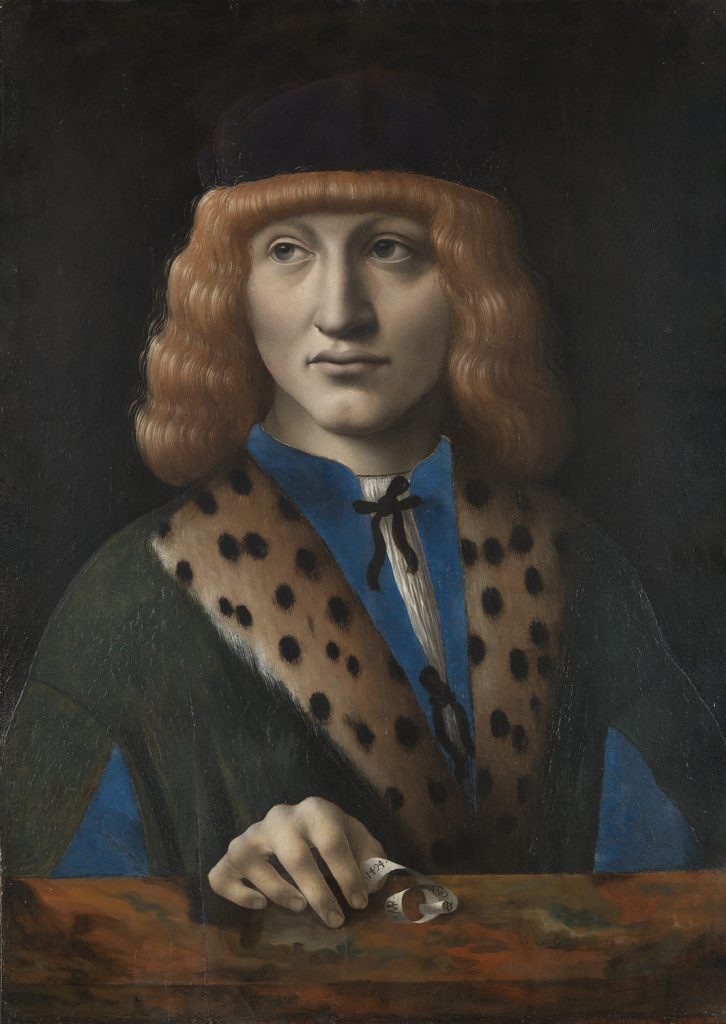
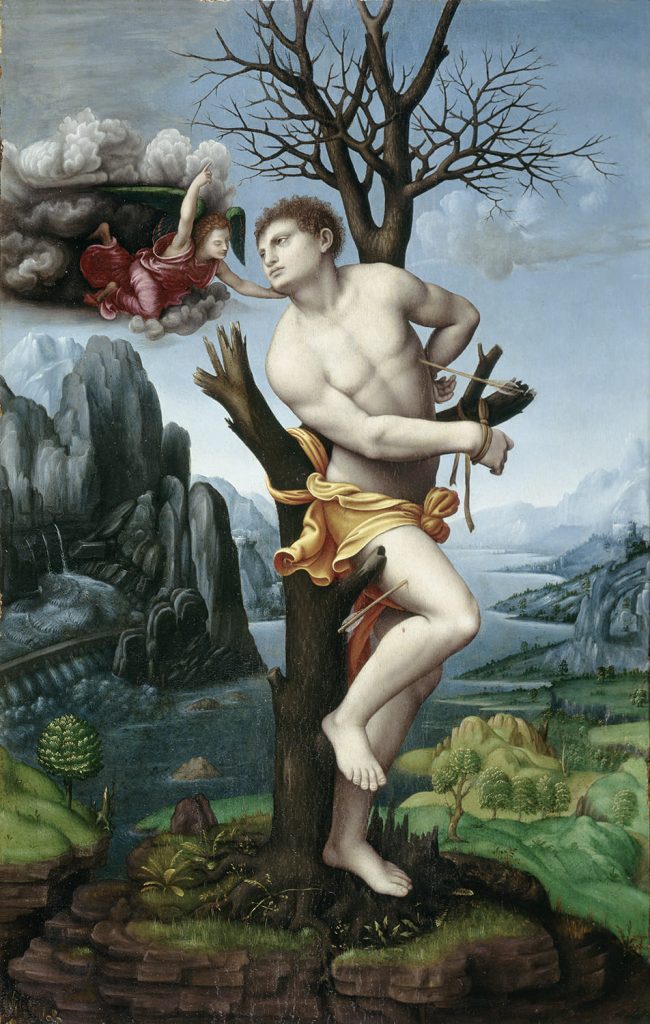
SAINT SEBASTIAN
Marco d’Oggiono (attributed),
Appro. 1499. Oil on poplar panel - 76x48,5 cm
Berlin, Gemäldegalerie
The pictorial work, part of a dismembered polyptych, is dated back to the end of the Milanese partnership with Leonardo and it seems to be inspired by a silver-pointed drawing by the master, kept at the Kunsthalle in Hamburg.
The authorship is disputable. Coming from a Florentine gallery, the painting is attributed to Marco d’Oggiono by Müller Walde (1896). The reference to the Lombard artist is shared by Carlo Marcora and Wilhelm Suida, who places it among the early d’Oggiono paintings. Instead, Domenico Sedini believes that the work is closer to Sodoma or Cesare da Sesto’s styles because of its stylistic elements.
Saint Sebastian, with Saint Rocco, is a typical thaumaturgical saint, protector against the plague, the same pandemic that probably caused Marco’s death (approx. 1524). The pestilence of 1524 went down in history as the plague of Charles V.
The depictions of Saint Sebastian and Saint Rocco can also be found together in the polyptych of the Assumption in the priory church of Saint Euphemia and also multiple times in the late Gothic frescoes by Tommaso Malacrida, inside the baptistery of Saint Giovanni Battista in Oggiono.
The work is located in Via 1º Maggio, 63, Oggiono LC.
MADONNA AND CHILD
Marco d’Oggiono,
approx. 1490. Tempera on panel – 65,5 x 53 cm
Auckland, Auckland Art Gallery
This is a Nursing Madonna, such as the Madonna Litta.
The characteristic curtain behind the two figures, well-established method of the Venetian and northern European painters, gives prominence to the two protagonists of the scene revealing on the sides a typical landscape dear to Marco.
The drapery, in contrast to the curtain, unfolds on the parapet on which the Child is sitting. The yellow-gold colour of the drapery symbolically dialogues with the bright red colour of the curtain alluding to the double nature of Christ; the bright and divine one and the carnal and human one.
The work is located in Via 1º Maggio, 86, Oggiono LC.
